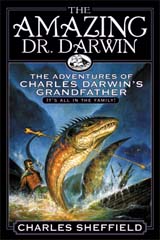
In these degenerate times when lawyers rule the world, most works of fiction are preceded by a nervous disclaimer that runs roughly as follows: "All characters in this book are fictitious. Any resemblance to actual persons, living or dead, is purely coincidental."
That cannot be considered one of the more exciting parts of the plot, and most people probably do not read it. The statement is there to discourage libel and defamation suits. I doubt that it helps. Like garlic against vampires, the disclaimer sounds comforting, but it never works when you really need it.
In this book I faced a different problem. Erasmus Darwin was undeniably a living, breathing human being, but his accomplishments were so substantial and diverse that it is difficult to portray him in fiction without being accused of painting him larger than life.
I do not think I have done that. If anything, I have understated the man. In breadth of interests, inventiveness, acquaintances (from King George III to Coleridge to James Watt to Ben Franklin), and human kindness, Darwin bestrode his age. He is arguably the greatest eighteenth century Englishman, a better candidate for that title than Chatham, Pitt the Younger, Pope, Sam Johnson, Marlborough, Priestley, Cavendish, or any other figure in the arts or sciences.
The claim is a large one. In an appendix to this book I have sought to support it, and at the same time drawn a dividing line between the facts and the fiction of each story. If you, like me, tend to read a book from the back forward, be warned: Statements contained in the Appendix reveal plot elements of each story.
On the other hand, if you are such a person, it is already too late. You will be reading this Introduction last of all. I hope that you enjoyed the stories.
—Charles Sheffield